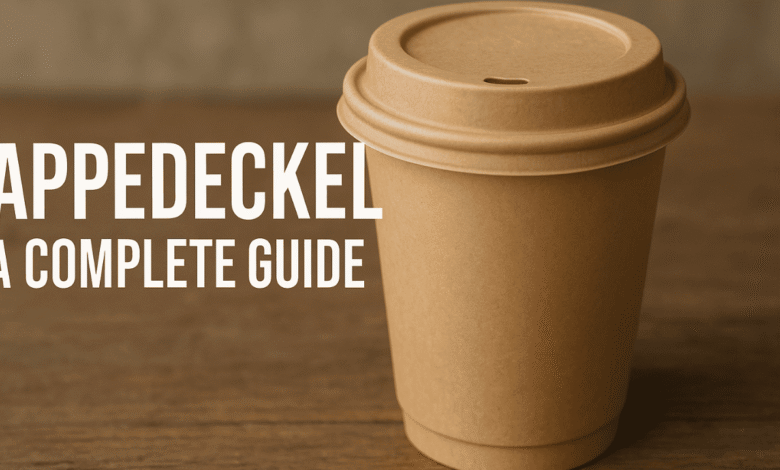Pappedeckel: A Complete Guide to the Cardboard Lid with History, Uses, and Environmental Value

The term pappedeckel comes from the German words “Pappe” meaning cardboard and “Deckel” meaning lid. It refers to cardboard lids and covers that have been widely used in packaging, food service, and even cultural traditions. While the pappedeckel may appear to be a simple item, it carries an impressive history and plays a significant role in sustainability and everyday life. From beer coasters in German pubs to eco-friendly alternatives in modern packaging, the pappedeckel has evolved into more than just a piece of cardboard.
The Origin and History of Pappedeckel
The history of the pappedeckel dates back to the late 19th and early 20th centuries. Originally, it was developed as an alternative to felt or wood coasters, providing a more hygienic and cost-effective solution. In 1903, Casimir Otto Katz created durable wood-fiber versions that became the foundation of modern beer coasters.
In German drinking culture, the pappedeckel became more than just a coaster. It was also a form of communication in pubs. Customers often placed the coaster over their glass to signal they were finished drinking, while leaving it uncovered indicated they wanted a refill. Over time, pappedeckel designs included logos, jokes, and artwork, turning them into collectible and cultural items.
Modern Uses of Pappedeckel
Today, the pappedeckel is not limited to beer coasters. Its uses have expanded widely across industries and daily life.
Food and Beverage Packaging
Cardboard lids are commonly used for takeaway coffee cups, soup containers, and food boxes. They provide spill protection, keep food fresh, and serve as an eco-friendly option compared to plastic lids.
Coasters in Cafés and Pubs
The traditional use of the pappedeckel as a coaster is still strong in Europe. They not only protect surfaces from moisture but also remain a unique cultural symbol, especially in German pubs.
Packaging and Shipping
Pappedeckel is also used inside shipping boxes as protective separators. They help stabilize fragile items and add an extra layer of security during transport.
Crafts and DIY
Beyond industrial use, pappedeckel has also made its way into crafts. Lightweight and versatile, it can be used in school projects, art decorations, or creative DIY ideas.
Environmental Significance of Pappedeckel
One of the most important aspects of the pappedeckel is its eco-friendly nature. Made from recycled or virgin paperboard, it is biodegradable and recyclable. Unlike plastic lids, which can take centuries to decompose, cardboard breaks down naturally and fits into recycling systems.
Pappedeckel supports the principles of the circular economy by reducing plastic waste and promoting renewable resources. Many businesses now prefer cardboard lids over plastic as part of their sustainability initiatives. This small change contributes to reducing environmental pollution and encourages eco-conscious consumer choices.
Manufacturing and Design of Pappedeckel
The production of pappedeckel involves shaping paperboard or cardboard into durable lids or coasters. Food-grade versions sometimes include a thin protective coating to resist moisture and heat.
Variants and Styles
There are multiple design styles for pappedeckel, from simple flat lids to reinforced versions with self-locking flaps. These designs ensure durability while remaining convenient for daily use.
Branding and Customization
Businesses often print their logos or marketing messages on pappedeckel. This makes them not only functional but also a tool for brand recognition. In the hospitality industry, coasters often feature local artwork, promotions, or humorous text, making them collectible items.
Innovation in Coatings
Recent developments have introduced biodegradable coatings that maintain strength and resist liquids without harming the environment. This innovation adds to the long-term sustainability of pappedeckel.
Challenges and Limitations of Pappedeckel
Despite its many advantages, the pappedeckel is not without challenges. Being a cardboard product, it is more sensitive to moisture compared to plastic lids. Prolonged exposure to steam or liquids may weaken its structure.
Another limitation is its structural rigidity. While plastic lids are often stronger, cardboard requires careful design to maintain strength. Manufacturers must also ensure a consistent supply of quality paperboard to meet high demand.
Cultural Role of Pappedeckel
Beyond its practical uses, the pappedeckel holds a strong cultural presence. In Germany, it became an integral part of pub life, with traditions and etiquette built around its use. It also represents social connection, as customized coasters often carry humor, art, or local identity.
Collectors around the world now seek rare or unique pappedeckel designs. This turns a simple piece of cardboard into a symbol of heritage and creativity.
Pappedeckel and the Future of Packaging
The demand for sustainable solutions is driving the growth of pappedeckel in the packaging industry. With global movements against plastic waste, more companies are switching to cardboard lids and coasters.
Future trends suggest that new biodegradable coatings, improved designs, and creative branding will make the pappedeckel even more relevant. It has the potential to become a global standard for eco-friendly packaging and beverage service.
Keys Takeaways about Pappedeckel
- Pappedeckel originated in Germany as beer coasters but evolved into versatile packaging solutions.
- It is widely used in food packaging, shipping, crafts, and hospitality.
- Being recyclable and biodegradable, it offers an eco-friendly alternative to plastic.
- Businesses use pappedeckel for branding, cultural expression, and customer engagement.
- While it has some limitations with moisture and rigidity, design innovations continue to improve its performance.
Conclusion
The pappedeckel may appear simple, but its story is rich with culture, functionality, and environmental value. From its origins in German pubs to its growing role in sustainable packaging, it demonstrates how small items can have a big impact. The combination of tradition, modern use, and ecological importance makes the pappedeckel more than just a cardboard lid. It represents innovation, culture, and the future of responsible consumption.
Frequently Asked Questions about Pappedeckel
Q1: What does the word pappedeckel mean?
Pappedeckel is a German term made from the words “Pappe” (cardboard) and “Deckel” (lid). It refers to cardboard lids or coasters used for drinks, food packaging, and various other purposes.
Q2: What is the origin of pappedeckel?
Pappedeckel originated in Germany in the late 19th and early 20th centuries. It was first used as a hygienic alternative to felt or wood coasters and later became a common feature in pubs, cafés, and packaging industries.
Q3: How is pappedeckel used today?
Today, pappedeckel is used as coffee cup lids, soup container covers, beer coasters, protective packaging inserts, and even in DIY crafts. Its versatility makes it popular in both commercial and personal use.
Q4: Is pappedeckel environmentally friendly?
Yes, pappedeckel is eco-friendly because it is biodegradable, recyclable, and often made from renewable paperboard. It is considered a sustainable alternative to plastic lids.
Q5: Can pappedeckel be customized?
Yes, businesses often print logos, artwork, and messages on pappedeckel for branding and marketing. Customized coasters and lids are also popular as collectibles.



